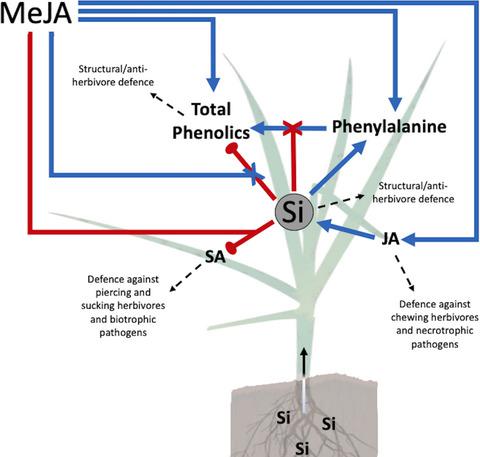当前位置:
X-MOL 学术
›
Funct. Ecol.
›
论文详情
Our official English website, www.x-mol.net, welcomes your
feedback! (Note: you will need to create a separate account there.)
Short‐term resistance that persists: Rapidly induced silicon anti‐herbivore defence affects carbon‐based plant defences
Functional Ecology ( IF 4.6 ) Pub Date : 2020-10-16 , DOI: 10.1111/1365-2435.13702 Jamie M. Waterman 1 , Casey R. Hall 1 , Meena Mikhael 2 , Christopher I. Cazzonelli 1 , Susan E. Hartley 3 , Scott N. Johnson 1
中文翻译:

持续的短期抵抗力:快速诱导的硅抗草食动物防御会影响基于碳的植物防御
更新日期:2020-10-16
Functional Ecology ( IF 4.6 ) Pub Date : 2020-10-16 , DOI: 10.1111/1365-2435.13702 Jamie M. Waterman 1 , Casey R. Hall 1 , Meena Mikhael 2 , Christopher I. Cazzonelli 1 , Susan E. Hartley 3 , Scott N. Johnson 1
Affiliation

|
- Silicon (Si) is known to alleviate diverse biotic and abiotic stresses including insect herbivory. Si accumulation in plants, notably the Poaceae, can be induced through stimulation of the jasmonic acid (JA) pathway (associated with chewing herbivores). Nevertheless, the temporal dynamics of Si accumulation as a defence response and its consequential effects on carbon‐based defences (e.g. phenolics), particularly in the short‐term, remain unclear.
- The model grass Brachypodium distachyon was grown in a hydroponic solution where half the plants were supplemented with 2 mM potassium silicate and half had no Si supplied. Plants were treated with methyl jasmonate (MeJA) as a form of standardised simulated herbivory. We measured Si accumulation, the phytohormones JA and salicylic acid (SA) and carbon‐based defences over 24 hr to determine the temporal dynamics of Si accumulation and the interplay between Si, simulated herbivory and plant defence machinery.
- MeJA‐induced Si accumulation occurred as early as 6 hr after treatment via increased JA concentrations. Si supplementation decreased SA concentrations, which could have implications on additional downstream defences. We show a trade‐off between Si and phenolics in untreated plants, but this relationship was weakened upon MeJA treatment. Further, this trade‐off did not apply to the phenolic precursor compound, phenylalanine.
- We provide evidence for rapidly induced Si accumulation associated with herbivory, and that increased Si accumulation impacts on phytohormones and carbon‐based defences over a 24‐hr period. Additionally, herbivory modifies the relationship between Si‐ and carbon‐based defences. Thus, in addition to its well‐documented role as a long‐term defence against herbivores, we demonstrate that, over short‐term temporal scales, Si accumulation responds to herbivore signals and impacts on plant defence machinery.
中文翻译:

持续的短期抵抗力:快速诱导的硅抗草食动物防御会影响基于碳的植物防御
- 已知硅(Si)可以减轻包括昆虫食草在内的各种生物和非生物胁迫。可以通过刺激茉莉酸(JA)途径(与咀嚼草食动物相关)来诱导植物(尤其是禾本科)中的硅积累。然而,尚不清楚Si积累作为防御反应的时间动态及其对碳基防御(例如酚类)的间接影响,特别是在短期内。
- 模型草短枝曲霉在水培溶液中生长,其中一半的植物补充了2 mM的硅酸钾,一半的植物没有供应Si。用茉莉酸甲酯(MeJA)处理植物,将其作为标准化模拟食草动物的一种形式。我们在24小时内测量了Si积累,植物激素JA和水杨酸(SA)以及基于碳的防御作用,以确定Si积累的时间动态以及Si,模拟食草动物和植物防御机制之间的相互作用。
- MeJA诱导的Si积累最早在治疗后6小时通过增加的JA浓度发生。硅的添加降低了SA的浓度,这可能会影响其他下游防御。我们在未经处理的植物中显示了硅与酚醛树脂之间的权衡,但是这种关系在MeJA处理后被削弱了。此外,这种折衷不适用于酚类前体化合物苯丙氨酸。
- 我们提供了与食草有关的快速诱导的Si积累的证据,并证明了在24小时内Si积累对植物激素和碳基防御的影响增加。此外,食草还改变了硅基防御和碳基防御之间的关系。因此,除了其有据可查的长期防御草食动物的作用外,我们还表明,在短期时间尺度上,硅的积累对草食动物的信号及其对植物防御机制的影响做出了响应。











































 京公网安备 11010802027423号
京公网安备 11010802027423号